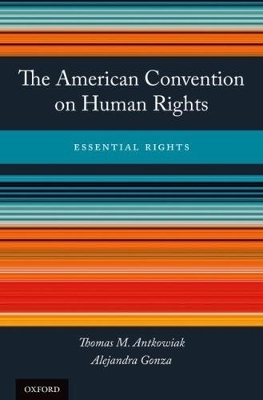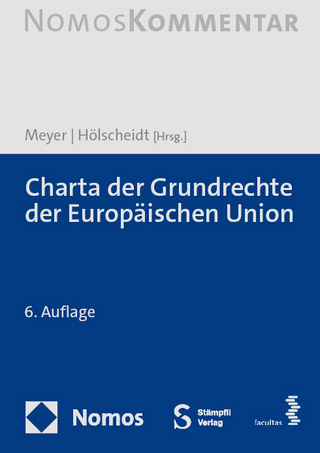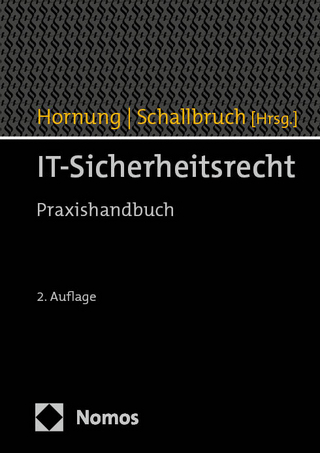
The American Convention on Human Rights
Oxford University Press Inc (Verlag)
978-0-19-998968-3 (ISBN)
Each chapter contains an Introduction to compare the Convention right's formulation with equivalent rights in other major international and regional treaties; a background section to consider the right's negotiation history; a Scope of Protection section to analyze the right's provisions (paragraph-by-paragraph or topic-by-topic); and lastly, a Limitations section, if applicable, to study any limitations to the right. In addition, the book's Introduction presents an up-to-date overview of the dynamic Inter-American Human Rights System, discussing the System's legal instruments, major institutions, significant impact, key developments, and current challenges.
Thomas M. Antkowiak is an Associate Professor of Law and Director of the Latin America Program at Seattle University School of Law, where he teaches international human rights, international law, and the international human rights clinic. Professor Antkowiak has litigated several matters before the Inter-American Commission and the Inter-American Court; he also served as a senior attorney at the Court. He has published numerous works on the Inter-American Human Rights System, including articles in leading international legal journals and an edited book. He received his law degree from Columbia Law School, and his undergraduate degree from Harvard University. Alejandra Gonza is Director of the International Human Rights Clinic at the University of Washington School of Law, and has significant experience in the Inter-American System. She served as a senior attorney at the Inter-American Commission and the Inter-American Court. She has published on freedom of expression, indigenous rights, property rights, and corporations in the Inter-American System. An Argentine lawyer, she received her law degree from Tucumán University (Argentina), and her master's degree in human rights from Pontifical University of Salamanca (Spain).
Chapter 1: Introduction
I. Overview
II. The Inter-American Human Rights System's Impact, Major Institutions, and Legal Instruments
A. Impact and Importance of the Inter-American System
B. The Organization of American States, the American Convention, and Other Critical Human Rights Instruments
C. The Inter-American Commission on Human Rights
D. The Inter-American Court of Human Rights
1. Introduction
2. The Court in Relation to the Commission
3. The Court's Ratione Materiae, Ratione Temporis, Ratione Personae, and Ratione Loci Jurisdiction
4. Note on the Court's Assessment of Evidence and Burden of Proof
III. Key Developments and Critiques of the Inter-American Jurisprudence
A. Introduction
B. Extensive State Obligations to Respect and Ensure Rights
C. Article 63: Reparations
D. Article 24: Right to Equality
E. Article 4: The Right to Life
F. Article 5: The Right to Humane Treatment
G. Article 7: The Right to Personal Liberty
H. The Rights to Due Process and Judicial Protection
1. Article 8: Right to a Fair Trial
2. Article 25: Right to Judicial Protection
I. Article 13: Freedom of Expression
J. Article 21: The Right to Property
IV. The Book's Structure and Methodology
Chapter 2: Equality
I. Introduction
II. Background
III. Scope of Protection
A. The Relationship of Article 24 and Article 1
B. The Assessment of Discrimination
1. Definitions and State Obligations
2. The Progression of the Court's Case Law: Discrimination in Law and in Fact
a. Introduction
b. Perceived Political Opponents
c. Disadvantaged Groups
d. Synthesis
3. Atala Riffo and the Court's Current Approach to Discrimination
Chapter 3: Life
I. Introduction
II. Background
III. Extensive State Obligations to Respect and Ensure the Right to Life
A. Introduction
B. Duty to Respect
C. Duty to Ensure (or "Protect")
1. Overview
2. Duty to Prevent through Legal Regulation
3. Duty to Adopt "Prevention and Protection Measures" in Threatening Circumstances
4. Duty to Investigate and Punish
IV. Scope of Protection
A. The Meaning of "Every Person" and "In General, From the Moment of Conception"
B. The Meaning of "No One Shall Be Arbitrarily Deprived" of Life
1. The Death Penalty
a. Introduction
b. "Only For The Most Serious Crimes"
c. The "Mandatory" Death Penalty
d. Due Process Requirements
e. Right to Apply for Pardon, Amnesty or Commutation
2. Use of Lethal Force in Law Enforcement Scenarios
a. Introduction
b. The Principles of Legality, Necessity and Proportionality
c. The Burden of Proof
d. State Duties After the Use of Force
3. Use of Lethal Force in Armed Conflicts
4. Arbitrary Deprivation of Life of Imprisoned Individuals
a. Introduction
b. Detention Conditions and Health Care
c. Security Operations in Prisons
5. Forced Disappearances of Persons
a. Introduction and Definition
b. The Right to Life and Ratione Temporis Jurisdiction
C. The Concept of Vida Digna
Chapter 4: Humane Treatment
I. Introduction
II. Background
III. Scope of Protection
A. A Broad Right with Uncertain Parameters
B. Definitions of Torture and the Inter-American Convention to Prevent and Punish Torture
C. The Inter-American Court's Three-Part Test for Torture
D. Involvement of State Actors: a Fourth Requirement?
E. Considerations of Evidence and Proof
F. Cruel, Inhuman, or Degrading Punishment or Treatment
1. Introduction
2. Sexual Violence and Violence against Women
3. State-Sanctioned Punishment
a. Corporal Punishment
b. The Death Penalty
c. Life Imprisonment: Children
4. Detention Conditions and Practices
5. Forced Disappearance
6. Threats of "Severe Physical Injuries"
7. Treatment of Children
G. Violations to Personal Integrity Below the Threshold of Article 5(2)
H. Investigation and Prevention: State Obligations to Ensure the Rights of Article 5
I. Article 5(3): No Extension of Punishment Beyond the Convicted Individual
J. Article 5(4): Separate Location and Treatment for Unconvicted Persons in Detention
K. Article 5(5): Separate Proceedings and Facilities for Children in Criminal Justice System
L. Article 5(6): "Reform and Social Readaptation" of Prisoners
Chapter 5: Personal Liberty
I. Introduction
II. Background
III. Scope of Protection
A. Overview
1. Right to Physical Liberty
2. Right to Personal Security
B. General Requirements to Deprive Liberty: the Principles of Legality and Arbitrariness
1. The Legality Principle
a. Restriction of Liberty Always the Exception
b. Ordered by a Competent Judicial Authority
i. Synthesis
ii. Detentions without Judicial Warrants: Exceptional Cases
c. State Obligation to Register Detentions
d. Detention Time Limits and Orders for Release
e. Pretrial Detention as Illegal Detention
f. Court's Increasing Reluctance to Find Violations of Article 7(2)
2. The Arbitrariness Principle
a. Synthesis
b. Forced Disappearances
c. Pretrial Detention as Arbitrary Detention
i. Sufficient Evidence of Criminal Responsibility
ii. Risks to the Criminal Proceeding
iii. Detention in Immigration Proceedings
iv. Pretrial Detention of Special Sectors of the Population
v. Time Limits for Pretrial Detention
3. Methodological Problems: Legality and Arbitrariness
C. The Specific Requirements of Paragraphs 4, 5, and 6 of Article 7
1. Article 7(4): Reasons for Detention and Notification of Charges
a. Reasons for Detention
b. Notification of Charges
2. Article 7(5): Judicial Supervision
a. Brought "Before a Judge or Other Officer Authorized by Law"
b. Right to Trial "Within a Reasonable Time"
3. Article 7(6): The Right to Habeas Corpus
4. Article 7(7): "No One Shall Be Detained for Debt"
Chapter 6: Due Process and Judicial Protection
Article 8: Right to a Fair Trial
I. Introduction
A. Many Similarities Among the Major Human Rights Treaties
B. Variances Among the Human Rights Systems
C. Background
II. Article 8(1)
A. Introduction and Meaning of "Right to a Hearing"
B. Meaning of "With Due Guarantees"
C. Meaning of "Within a Reasonable Time"
D. Meaning of "Competent, Independent, and Impartial Tribunal, Previously Established by Law"
1. "Tribunal"
2. "Competent"
3. "Independent"
4. "Impartial"
5. "Previously Established by Law"
III. Article 8(2) and the Right to Be Presumed Innocent
A. Article 8(2)(a): the Right to be Assisted by a Translator or Interpreter
B. Article 8(2)(b): Prior Notification in Detail of Charges
C. Article 8(2)(c): Adequate Time and Means for Preparation of Defense
D. Article 8(2)(d): the Right to Defend Oneself Personally or to Be Assisted by Legal Counsel, and to Communicate Freely and Privately with Counsel
E. Article 8(2)(e): the Right to be Assisted by Counsel Provided by the State
F. Article 8(2)(f): the Right of the Defense to Present and Examine Witnesses
G. Article 8(2)(g) and Article 8(3): the Right Not to Be Compelled to Be a Witness against Oneself; Coercion and Confessions
H. Article 8(2)(h): the Right to Appeal a Judgment to a Higher Court
I. The Right to Effective Access to Consular Assistance
IV. Article 8(4): An Acquitted Person Shall Not Be Subjected to a New Trial for the Same Cause
V. Article 8(5): Public Criminal Proceedings
Article 25: Right to Judicial Protection
I. Introduction and Background
II. Article 25(1): "Simple, Prompt and Effective" Remedies
A. "Simple" and "Prompt" Remedies
B. "Effective" Remedies
III. Article 25(2): Enforcement of National Judgments
IV. The Boundaries of "Judicial Protection"
A. The Right of Access to Justice
B. Combining Articles 8 and 25: A Critique
C. The Court's Current, Broader View of Article 25
Chapter 7: Freedom of Expression
I. Introduction
II. Background
III. Scope of Protection
A. The Meaning of "Everyone"
B. Protected Expression
C. Safeguards for Journalists
D. Right of Access to State-Held Information
IV. Limitations to Article 13
A. Introduction
B. Prior Censorship
1. Overview
2. Prohibitions against Offensive Content
C. Subsequent Imposition of Liability
1. Overview and General Requirements
2. Subsequent Criminal Liability
a. Introduction
b. The Honor and Reputation of the Armed Forces
c. The Honor and Reputation of Public Officials
3. Subsequent Civil Liability
D. "Indirect" Restrictions
E. Cases of Persecution Leading to Generic Violations of Article 13(1)
F. Incitements to Violence: Article 13(5)
Chapter 8: Property
I. Introduction
II. Background
III. Scope of Protection
A. Many Forms of Property Recognized
B. Rights to Communal Property
IV. Limitations to Article 21
A. Right to Property Not Absolute
B. Meaning of "Just Compensation"
C. Meaning of "Reasons of Public Utility or Social Interest"
D. Meaning of "In the Cases and According to the Forms Established by Law"
E. Specific Approaches to Limitations
1. Restrictions during Criminal Investigations and Police Action
2. Protective Framework for Traditional Territories
Chapter 9: Reparations
I. Introduction
II. Background
III. The "Injured Party" of Article 63(1) and Related Topics
IV. Monetary Remedies
A. Pecuniary Damages
B. Moral Damages
1. In General
2. Community Development Programs
V. Non-Monetary Remedies
A. Background
B. Restitution
C. Rehabilitation
D. Recognition of Responsibility and Apologies
E. Memorials and Commemorations
F. Reform of Legislation and Policy, Training Programs
VI. Legal Fees and Expenses
VII. Supervision and Compliance with the Court's Judgments
A. Binding and Final Nature of Judgments
B. Introduction to Supervision
C. Cases of Noncompliance
D. Compliance Rates
VIII. Provisional Measures of Article 63(2)
Appendix: List of Inter-American Court Judgments by Convention Article
Index
| Erscheinungsdatum | 30.06.2017 |
|---|---|
| Verlagsort | New York |
| Sprache | englisch |
| Maße | 236 x 155 mm |
| Gewicht | 703 g |
| Themenwelt | Recht / Steuern ► EU / Internationales Recht |
| Recht / Steuern ► Öffentliches Recht ► Völkerrecht | |
| Sozialwissenschaften ► Politik / Verwaltung | |
| ISBN-10 | 0-19-998968-0 / 0199989680 |
| ISBN-13 | 978-0-19-998968-3 / 9780199989683 |
| Zustand | Neuware |
| Haben Sie eine Frage zum Produkt? |
aus dem Bereich


